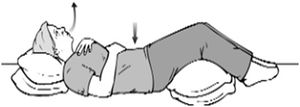Diaphragmatic Breathing Exercises: Difference between revisions
No edit summary |
Kim Jackson (talk | contribs) m (Reverted edits by Hing Long Yip (talk) to last revision by Kim Jackson) |
||
| Line 2: | Line 2: | ||
== Introduction== | == Introduction== | ||
Diaphragmatic breathing is intended to help you use the diaphragm correctly while breathing to: | |||
* Strengthen the diaphragm | |||
* Decrease the work of [[Breathing Pattern Disorders|breathing]] by slowing your breathing rate | |||
* Decrease oxygen demand | |||
* Use less effort and energy to breathe | |||
---- | |||
== Diaphragmatic breathing technique == | == Diaphragmatic breathing technique == | ||
'''1)'''Lie on your back on a flat surface or in bed, with your knees bent and your head supported. You can use a pillow under your knees to support your legs. Place one hand on your upper chest and the other just below your rib cage. This will allow you to feel your diaphragm move as you breathe[[File:9445-hic-diaphragmatic-breathing-1.jpg|center|thumb| | '''1)'''Lie on your back on a flat surface or in bed, with your knees bent and your head supported. You can use a pillow under your knees to support your legs. Place one hand on your upper chest and the other just below your rib cage. This will allow you to feel your diaphragm move as you breathe[[File:9445-hic-diaphragmatic-breathing-1.jpg|center|thumb| | ||
diaphragmatic-breathing | diaphragmatic-breathing | ||
| Line 19: | Line 20: | ||
]] | ]] | ||
'''3)'''Tighten your stomach muscles, letting them fall inward as you exhale through pursed lips. The hand on your upper chest must remain as still as possible. | '''3)'''Tighten your stomach muscles, letting them fall inward as you exhale through pursed lips (see "Pursed Lip Breathing Technique"). The hand on your upper chest must remain as still as possible. | ||
[[File:9445-hic-diaphragmatic-breathing-3.jpg|center|thumb| | [[File:9445-hic-diaphragmatic-breathing-3.jpg|center|thumb| | ||
-hic-diaphragmatic-breathing-3 | -hic-diaphragmatic-breathing-3 | ||
]] | ]] | ||
== References== | == References== | ||
Revision as of 18:29, 23 February 2020
Introduction[edit | edit source]
Diaphragmatic breathing is intended to help you use the diaphragm correctly while breathing to:
- Strengthen the diaphragm
- Decrease the work of breathing by slowing your breathing rate
- Decrease oxygen demand
- Use less effort and energy to breathe
Diaphragmatic breathing technique[edit | edit source]
1)Lie on your back on a flat surface or in bed, with your knees bent and your head supported. You can use a pillow under your knees to support your legs. Place one hand on your upper chest and the other just below your rib cage. This will allow you to feel your diaphragm move as you breathe
2)Breathe in slowly through your nose so that your stomach moves out against your hand. The hand on your chest should remain as still as possible
3)Tighten your stomach muscles, letting them fall inward as you exhale through pursed lips (see "Pursed Lip Breathing Technique"). The hand on your upper chest must remain as still as possible.
References[edit | edit source]
COPD Foundation. What is COPD? Accessed 4/11/2019.
Centers for Disease Control and Prevention. Chronic Obstructive Pulmonary Disease (COPD). Accessed 4/11/2019.









